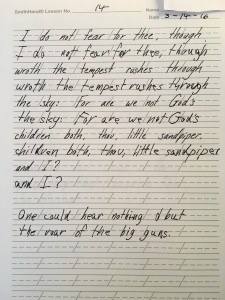 So how do those Charlotte Mason methods work out for a simpler schoolday? Here is a peek into the days of my K-er and 3rd-grader.
So how do those Charlotte Mason methods work out for a simpler schoolday? Here is a peek into the days of my K-er and 3rd-grader.
Kindergarten: Pearl listens in on Duncan’s read-aloud time (this is at her wish, I do not require it) and then has her own. Her read-alouds contain a Bible story, a Psalm, a few poems, and her book from the Wee Folk Art program. I ask her to orally narrate one of these items maybe once a week.
She does not read yet, so we may work on a few pages of a phonics book. (I have rec’s at the end of my What Subjects? post.)
We tried beginning a handwriting program in preparation for copywork, but she found it frustrating, so we put it away until next year. She works on fine motor skills by coloring a lot with colored pencils.
3rd Grade: Duncan’s read-aloud time contains a Bible story, a Psalm, a few poems, and a chapter of quality children’s literature. I have him narrate just one of these items each day. He also has a required hour of reading with books of his choice, in addition to a reading in his history or science book. Then we have a family read-aloud time at bedtime. In other words, lots of reading.
Later he goes to the table with pen and paper. For the first half of the year, we focused solely on copywork. Copywork is appropriate for K and up, but consider your student’s fine motor skills before you begin. Duncan was not ready for handwriting until this year, 3rd grade. This is not unusual for boys. Thankfully, the reading and narrating kept him moving forward in skills needed for writing until his physical abilities caught up.
For the second semester, we have been doing dictations. Both copywork and dictations contain opportunities to learn the mechanics of writing (spelling, capitalization, and punctuation). Make it a habit to point out the capital letters and why they’re used, as well as the punctuation marks. This is natural, contextual learning. For more on using dictation as a teaching tool, check out Bonnie Landry’s booklet on Dictation.
Here is a recent example of Duncan’s copywork and dictation for a day: 
The copywork was from a poem we read and the dictation was from his literature reading. You can see I am writing out his copywork for him to copy, but by next year he will be taking it straight from the source.
***
And that’s what our language arts look like with young children. Each of these skills are started with very short passages, and gradually lengthened as students’ skills mature. The content can be taken from the books your students are reading, which helps spark their interest, and makes your learning more cohesive. Each skill is added on to the previous one. You start with just copywork, then add dictation while still doing copywork. Then around 4th grade, begin doing short written narrations on top of the copywork and dictations. It is helpful to think in terms of skill level rather than grade level. Is your student ready for the next step, regardless of their grade?
Many CM adherents require an oral narration for every reading; I do not. The main reason is I don’t want it to become overly burdensome. I drop oral and written narrations sometime in middle school, and then they begin regular composition work, as well as grammar. Copywork and dictation are short and have enough benefits that I continue those for awhile. I actually still have my 9th-grader doing copywork in a commonplace book, because there is so little opportunity for handwriting these days.
One important point if you want CM skills to simplify your day: they are meant to replace other language arts curricula. Many homeschool parents love the idea of Charlotte Mason, but they add her practices on top of traditional curriculum. While this may work, it complicates your day rather than simplifying it. CM’s ideas are effective enough to stand on their own.
<–PREVIOUS: The Language Arts – Part Two
[…] –>NEXT: The Language Arts – In Real Life […]